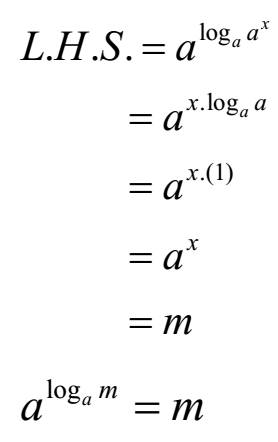Science > Mathematics > Algebra > Logarithms > Laws of Logarithm
In this article, we shall study the laws of logarithm and their proofs. Laws of logarithm are very important in mathematics and every student should have confidence in using them.
Laws of Product:
loga(mn) = logam + logan, where a, m, n are positive real numbers with a ≠ 1
Proof:
Let logam = x and logan = y ……. (1)
By the definition of logarithm, we have
ax = m and ay = n
Now mn = ax . ay
mn = ax + y
By definition of logarithm
loga (mn) = x + y
Substituting values of x and y from relation (1) we get
loga (mn) = logam + logan (Proved)
Corollary:
loga(mnp) = logam + logan + logap
Proof:
L.H.S. = loga (mnp)
∴ L.H.S. = loga (mn) + loga (p) (Law of product)
∴ L.H.S. = loga m + loga n + loga p (Law of product)
loga(mnp) = logam + logan + logap (Proved)
Law of Quotient:
loga(m/n) = logam – logan, where a, m, n are positive real numbers with a ≠ 1, n ≠ 0
Proof:
Let logam = x and logan = y ……. (1)
By the definition of logarithm, we have
ax = m and ay = n
Now m/n = ax / ay
m/n = ax – y
By definition of logarithm
loga (m/n) = x – y
Substituting values of x and y from relation (1) we get
loga (m/n) = logam – logan (Proved)
Corollary:
loga(mn/pq) = logam + logan – logap – logaq
Proof:
L.H.S. = loga(mn/pq)
∴ L.H.S. = loga(mn) – loga(pq) (Law of quotient)
∴ L.H.S. = (logam + logan) – (logap + logaq) (Law of product)
∴ L.H.S. = logam + logan – logap – logaq
loga(mn/pq) = logam + logan – logap – logaq (Proved)
Law of Exponent:
logamn = n. logam where a, m, n are positive real numbers with a ≠ 1
Proof:
Let logam = x ……. (1)
By the definition of logarithm, we have
ax = m
mn = (ax)n = anx
By definition of logarithm
logamn = n x
Substituting value of x from relation (1) we get
logamn = n logam (Proved)
Corollary:
loga(xpyq/zrws) = (p logax + q logay) – (r logaz + s logaw)
Proof:
L.H.S. = loga(xpyq/zrws)
∴ L.H.S. = loga(xpyq) – loga(zrws) (Law of quotient)
∴ L.H.S. = (logaxp + logayq) – (logazr + logaws) (Law of product)
∴ L.H.S. = (p logax + q logay) – (r logaz + s logaw) (Law of exponent)
∴ L.H.S. = p logax + q logay – r logaz – s logaw
loga(xpyq/zrws) = (p logax + q logay) – (r logaz + s logaw) (Proved)
Logarithm of 1 to Any Base
Loga1 = 0 i.e. Logarithm to any base is always zero.
Proof:
Let loga1 = x ………. (1)
By definition of logarithm
ax = 1
ax = a0
x = 0
Substituting this value in equation (1) we get
loga1 = 0 (Proved)
Logarithm of Any Number to the Same Base:
logaa = 1 i.e. Logarithm of any number to the same base is 1
Proof:
Let logaa = x ………. (1)
By definition of logarithm
ax = a
ax = a1
x = 1
Substituting this value in equation (1) we get
logaa = 1 (Proved)
Important Property:

where a and m are positive real numbers with a ≠ 1
Proof:

Let log am = x
By definition of logarithm
ax = m
Substituting in equation (1)

(Proved)
Change of Base Law:

where a, b, and m are positive real numbers with a ≠ 1 and b ≠ 1
Proof:
Let logam = x, logbm = y and logba = z ……. (1)
By the definition of logarithm, we have
ax = m ……….. (2)
by = m ……….. (3)
bz = a ……….. (4)
From equations (2) and (3)
ax = by ……….. (5)
Substituting value of a from equation (4) in (5) we get
(bz)x = by
bzx = by
zx = y
x = y/z
Substituting the values of x, y, and z from equation (1) we get

(Proved)
Corollary:

Proof:
We have

Substitute m = b

(Proved)
In the next few articles, we shall study how to use the laws of logarithm to evaluate or simplify given logarithmic expression.
One reply on “Laws of Logarithms”
wow i really in proved my maths skill here